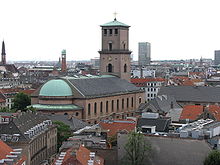Church of Our Lady, Copenhagen
| Church of Our Lady | |
|---|---|
| Vor Frue Kirke | |
 |
|
| Location | Copenhagen |
| Country | Denmark |
| Denomination | Church of Denmark |
| Website | koebenhavnsdomkirke |
| Architecture | |
| Status | Cathedral |
| Architect(s) | Christian Frederik Hansen |
| Style | Neo-Classicism |
| Completed | 1829 |
| Specifications | |
| Height | 60 m |
| Administration | |
| Diocese | Copenhagen |
| District | City Centre |
| Clergy | |
| Bishop(s) | Peter Skov-Jakobsen |
The Church of Our Lady (Danish: Vor Frue Kirke) is the cathedral of Copenhagen. It is situated on Frue Plads and next to the main building of the University of Copenhagen.
The present day version of the church was designed by the architect Christian Frederik Hansen in the neoclassical style and was completed in 1829.
Construction of the original Collegiate Church of St. Mary, began no later than 1187 under Bishop Absalon. The church was located on the highest point near the new town of Havn, later Copenhagen. Bishop Absalon (1128–1201) was Bishop of Roskilde (Zealand), Denmark's capital of that era, and spent most of his life securing Denmark from foreign attacks. He built many churches and monasteries, while also founding Copenhagen as Denmark's Baltic port city. Named Archbishop of Lund in 1178, Absalon accepted only under threat of excommunication. St. Mary's construction continued sporadically until 1209, when it was consecrated by Absalon's successor, Bishop Peder Sunesen on Annunciation Sunday in March, which became the church's traditional feast day. The church was built in Romanesque style with its half-rounded arches inside and out.
In 1314, a fire destroyed the limestone church so completely that it was rebuilt in the popular new building material of the day, over-sized red brick. The style of building was Gothic, with its typical pointed arches. The rebuilding of the simple church with a long nave and choir continued until 1388. Due to a lack of money, the great tower was not built until the reign of Christian II. It was as high as the church was long, and from artwork of the day, out of proportion to the size of the church.
A school was established early on. In 1479, parts of the church school received a charter and become the University of Copenhagen. Professors were brought from Cologne, Germany. The international faculty widened Denmark's exposure to the great ideas and philosophies of the day. The university challenged the growth of the Protestant movement, but was eventually closed. By 1537 it reopened as a centre for Lutheran studies.
...
Wikipedia
